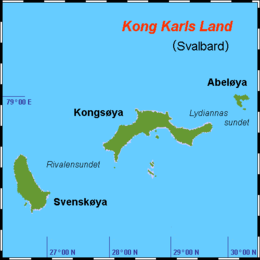Native name: Kong Karls Land | |
|---|---|
 Map of Kong Karls Land | |
 | |
| Geography | |
| Location | Northern Europe |
| Coordinates | 78°45′N 28°30′E / 78.750°N 28.500°E |
| Archipelago | Svalbard |
| Total islands | 5 |
| Major islands | Kongsøya, Svenskøya, Abel Island, Helgoland Island, and Tirpitzøya |
| Area | 342 km2 (132 sq mi) |
| Administration | |
Norway | |
| Demographics | |
| Population | 0 |
Kong Karls Land or King Charles Land is an island group in the Svalbard archipelago, in the Arctic Ocean. The island group covers an area of 342 km2 (132 sq mi) and is made up of the islands of Kongsøya, Svenskøya, Abel Island, Helgoland Island, and Tirpitzøya.
The islands, which have the largest concentration of polar bear in Svalbard, are part of the Nordaust-Svalbard Nature Reserve, along with Nordaustlandet and Kvitøya. There is a ban on traffic to the islands, which includes the areas of the sea up to 500 metres away from shore and the airspace up to 500 metres above the area.
Kong Karls Land was discovered by an expedition sent by the Muscovy Company in 1617,[1] probably from a high point on Barentsøya. They named the group Wiche Islands, after a member of the company, Richard Wyche.
In the mid-19th century, the islands were rediscovered, and in 1859 the Norwegian Erik Eriksen made the first landing on Svenskøya. In 1870, the Württemberger Theodor von Heuglin named the archipelago King Charles Land after his King Charles I of Württemberg.
- ^ Conway, William Martin (1906). No Man's Land: A History of Spitsbergen from Its Discovery in 1596 to the Beginning of the Scientific Exploration of the Country. Cambridge, At the University Press.